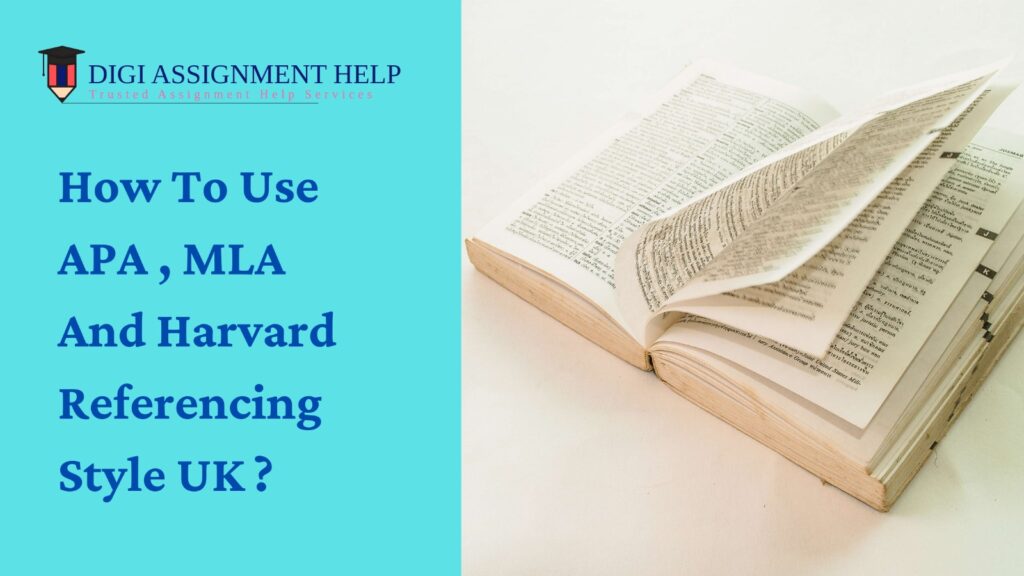Scholars must prevent plagiarising and boost the credibility of their work by referencing, an essential part of academic writing. The UK uses many referencing styles, each with its own rules. Discover the three most used citation styles—APA, Harvard, and MLA—in this comprehensive tutorial. Keep on reading this blog to learn more details.

APA Style
Social sciences use APA style, including sociology, education, and psychology. Author and publication date citations are easier to read, helping readers establish when the article was published.
In-Text Citations
APA in-text citations should include the author’s last name and publication year. Example citation: (Smith, 2020). Example: (Smith, 2020, p. 15) would be an example of a direct quote that requires page numbers.
Reference List
The APA reference list begins flush left and is indented from the following lines. The first author’s surname should be alphabetically referenced.
When to Use APA
APA style suits disciplines that value research timeliness. Psychologists and educators love it because of this.
Harvard Style
Many fields in the United Kingdom employ the Harvard referencing style, which is most prevalent in the social and humanities. Its author-date system is well-known and comparable to APA’s but differs meaningfully.
In-Text Citations
The year of publication and the author’s surname are also required in Harvard citations. For example, the standard in-text reference format is (Jones, 2019). Jones (2019, p. 22) specifies the proper syntax for page numbers when quoting directly.
Reference List
The reference list should be structured according to the author’s last name in Harvard style. Institutions can differ in the formatting.
When to Use Harvard
One of the most used citation styles in the UK, Harvard, is quite adaptable and may be used in many academic fields.
MLA Style
There is a preponderance of MLA-style citations in the arts, philosophy, literature, and humanities. Unlike APA and Harvard, it places more emphasis on the author’s name and the page number and less on the publication date.
In-Text Citations
(Smith 15) is an example of an in-text citation in MLA style, which requires only the author’s last name and the page number (without a comma). In fields where textual analysis is crucial, this brief style is beneficial.
Works Cited
An MLA-style hanging indent formats the “Works Cited” page. Authors’ last names should be used to sort the entries alphabetically.
When to Use MLA
MLA is well-suited to fields like language and literature because of its widespread usage in the arts and humanities. It is the favoured choice for analysis and critique due to its simplicity and focus on the text.
APA vs Harvard vs MLA Referncing Style
| Feature | APA Style | Harvard Style | MLA Style |
| Disciplines | Social sciences (sociology, education, psychology)1 | Social sciences and humanities2 | Arts, philosophy, literature, humanities3 |
| Emphasis | Author and publication date1 | Author and date2 | Author’s name and page number3 |
| In-Text Citation | (Smith, 2020)4 | (Jones, 2019)2 | (Smith 15)5 |
| Direct Quote | (Smith, 2020, p. 15)4 | Jones (2019, p. 22)2 | (Smith 15)5 |
| Reference List | Alphabetical, flush left, indented4 | Alphabetical by author’s last name3 | “Works Cited” with hanging indent5 |
| Key Usage | Research timeliness4 | Adaptable across academic fields3 | Textual analysis and critique5 |
Other Referencing Styles
Numerous referencing styles are utilised in particular domains, including APA, Harvard, and MLA. For example, using footnotes and a bibliography is commonplace in historical, and some social science works in the Chicago style. The medical and scientific communities rely on numbered references and employ the Vancouver style. How to Choose the Right Style
Choosing the Right Style
When choosing a citation style, discipline, institutional policy, or journal specifications should be considered. Check the course requirements or talk to your advisor to ensure you are using the right style. Because every style has its subtleties, it is crucial to know the guidelines by heart.
General Tips for Effective Referencing
Be Consistent
Being consistent is essential, regardless of the style you pick. Always use the same citation style when citing sources in your work.
Keep Detailed Notes
Keep careful notes if you want your sources properly cited when you write up your study. Making your reference list will be a breeze with this.
Utilize Reference Management Tools
Consider utilising reference management software such as Mendeley, EndNote, or Zotero. You can automate formatting and keep your references organised using these tools.
Review Your Institution’s Guidelines
Be sure to verify with your school or department if there are any particular criteria. Certain schools may have their unique preferences or styles.
Proofread Your References
Your reference list and in-text citations should be double-checked for accuracy and style compliance before you submit.
Conclusion
One of the most essential skills for academic writing is knowing how to cite sources correctly. Clarity, uniformity, and following the guidelines are the most critical factors while utilising any style, be it APA, Harvard, MLA, or any another. By mastering these styles, you may boost your work’s reputation and help readers find and verify sources. It is a win-win for the academic community. Having a firm understanding of these referencing patterns will benefit you in your studies and beyond as you begin your academic path. Digi Assignment Help UK is an excellent resource for students facing these issues. International students with a lot on their plates will find this helpful resource. We ensure they complete their assignments on time and achieve their academic goals.



